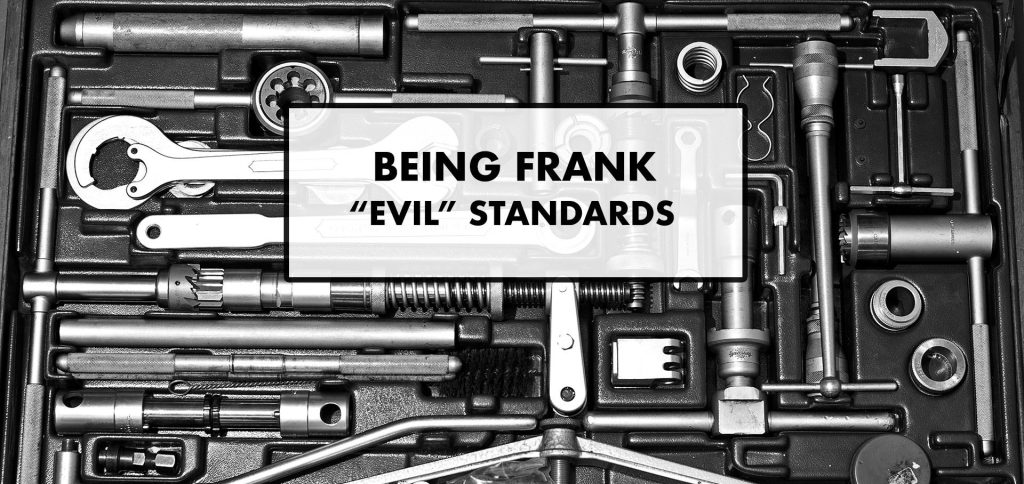

“An industry standard is a generally accepted set of criteria within an industry relating to the standard function, specification, and/or compatibility of a product or operation.”
Want to ignite an incendiary response from the forum trolls? Just say there’s a “new standard” for a bicycle product. As a consumer that cherishes product of good design and function, it warms my heart when a product has an extended useful life due to serviceability and compatibility. For those that started riding before there were mountain bikes as we know them, the Silca Pista pump is a fine example. The one I bought in 1986 still does the job it was designed for, can still be serviced with available parts, AND is still compatible with the valve stems used on most performance bikes. To grasp how absolutely remarkable that is, considering how many products one can say that about. A phone from thirty years ago? How about a camera or computer? A washing machine? A television? Yes, at one time we could and did repair our own TVs. But all of the modern versions of those products are infinitely more capable, and who would choose a 25” black and white console TV over a 55” OLED with a 4K UHD flat screen for the ability to replace vacuum tubes and place a fish bowl on top?
Nonetheless, when a company announces its new product was made possible due to changes to conventional specifications, particularly how said product interfaces with its mates — the accusations range from conspiracy to greed, idiocy, malice, stupidity, and more. It seems rational to desire that one’s carefully considered purchases are as useful as long as possible. However, it is just as irrational to call someone a flaming a-hole for trying to make a product function better. I don’t think the complaints are a new thing – just that technology has made it so easy to share our thoughts even before we have thought them through. So, this has been going on for a long time, and it seems to imply that the “standard” at any given point in time should remain the standard. Or in other words, “this is as good as it gets or as good as we need so don’t change anything”.
Hmm… at any given point in time? How about 1985 before Shimano perfected indexed shifting? After all, to partake in one of the biggest improvements in bicycle history required using an unconventional linearly noncompressible housing. Maybe 1991 before the advent of the threadless headset? A bigger offender than indexed shifting because one’s existing stem and fork had to be replaced. Or what about 1995 before Hayes introduced the first modern mountain bike disc brake (that actually worked!) but required specific frame and fork mounts? And about that same time a small research team created the virtual pivot (VPP) full suspension concept that beget many, if not most of the popular designs of today. Side note here: in one of my best bonehead moves, I passed on the Outland design that later boosted Santa Cruz into orbit. What about 2000 before Hutchinson (along with Mavic) introduced mountain bike riders to tubeless tires? But those tires required a new… yes, rim standard. Would 2011 be the year to freeze product evolution? There were some damn good bikes then, but they had two or three front chain rings before SRAM perfected 1X. Yes, 1X required the use of a new standard, the XD freehub. Or the years before 29 inch wheels, suspension forks, carbon fiber frames, or wide rims?
Certainly there have been advancements that did not result in incompatibility with mainstream bike design of the day. Dropper posts, wireless drivetrains, wide MTB bars, clamp-on grips, and others. But usually the most impactful necessitated a new way to be integrated or interfaced with. That impact is a function of evolution driven by the imagination of how to expand the fun and use of a bicycle. Unfortunately there are DUB, uh I mean dumb ideas that bring change of dubious benefit, make a situation worse, are made without due consideration of the consequences, follow fads, etc. without providing that great impact on our riding experience. It would be a tragedy to deny us the experience-changing impact of bicycle design evolution due to the frustration borne from the minority of products that are true abominations. After all, who knows what 2020 holds? There is nothing that is the last word in design.
Monday: 10:00 am – 5:00 pm
Tuesday – Thursday: 10:00 am – 5:00 pm
Friday: 10:00 am – 5:00 pm
Saturday – Sunday: Closed